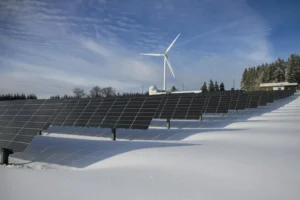
17 Ideas About( How To Choose The Best Area For Commercial Solar Installation)
Introduction
Commercial solar installation is gaining recognition as agencies apprehend the environmental and monetary blessings of harnessing solar energy. Various factors, including daylight exposure, available areas, local guidelines, and financial incentives, normally determine the best area for a solar business setup.
Choosing the Best Location for Commercial Solar Installation
When thinking about the first-class vicinity for commercial solar installation, it’s crucial to assess the solar potential of the location. Areas with high sunlight levels throughout the year are ideal for maximizing solar energy production. It may be determined through solar irradiation maps and consulting with solar strength experts. Another important area of attention is the provision of space for solar panels. Commercial homes with huge rooftops or open land adjacent to them provide sufficient opportunities for solar installations.
Optimizing Solar Installation: Orientation and Regulatory Compliance
Proper orientation and shading analysis ensure the most beneficial electricity era. Local guidelines are critical in determining the feasibility of commercial solar installations. Some areas have particular zoning regulations or building codes that inspire or restrict solar development. It is crucial to analyze and comply with these policies to ensure a smooth setup procedure
17 Ideas About( How To Choose The Best Area For Commercial Solar Installation)
Choosing a great location for industrial solar installation requires careful consideration of numerous elements. Here are 17 thoughts to help you make an informed decision:
- 1. Assess Sunlight Availability: Determine the common quantity of sunlight the vicinity receives at some stage in the 12 months. Areas with high solar irradiation degrees are extra favorable for solar power production.
- 2. Consider Roof Orientation: If solar panels are installed on the roof, examine their orientation to optimize sun publicity. South-going rooftops generally acquire the maximum daylight within the northern hemisphere.
- 3. Evaluate Roof Condition: Ensure the roof is structurally sound, which might guide the weight of solar panels. Conduct an expert inspection and plan for any necessary upkeep or reinforcements.
- 4. Analyze Shading: Identify sources of shade, including nearby homes or bushes, that may obstruct sunlight and decrease strength manufacturing. Minimizing shading is vital for the solar panel’s overall performance.
- 5. Review Energy Consumption: Analyze your commercial enterprise’s strength intake to decide the size of the sun installation required. Consider your strength needs, as it should be the device’s size, and maximize financial savings.
- 6. Research Local Regulations: Familiarize yourself with neighborhood zoning policies, building codes, and allowing necessities for sun installations. Ensure compliance with the rules to avoid any legal issues.
- 7. Financial Incentives: Research nearby and country-wide monetary incentives, tax credits, offers, and rebates that can offset the fee of solar installation. Factor in those incentives while figuring out the economic feasibility of the undertaking.
- 8. Consult Experts: Seek advice from solar strength professionals or experts who can examine your commercial enterprise’s specific needs and endorse the high-quality approach for solar setup.
- 9. Calculate Return on Investment: Conduct a complete monetary evaluation to determine the payback length and return on investment for the solar assignment. Consider setup expenses, power financial savings, and ability revenue from extra-strength production.
- 10. Consider Energy Storage: Explore the opportunity of incorporating power garage systems to save excess power generated during the day for use during low daylight periods or in the event of a power outage.
- 11. Assess Grid Connection Options: Determine the most viable connection technique, whether connecting to the neighborhood power grid or choosing an off-grid machine. Consider the fees, reliability, and capability advantages of each alternative.
- 12. Available Space: Evaluate the space for solar installations and unused land or parking masses. Consider floor-installed sun structures if the roof space is limited or deemed wrong.
- 13. Long-Term Plans: Consider your business’s plans for a lengthy period and its capacity for future expansions. Choose an area that permits scalability, accommodating extra solar panels as the company grows.
- 14. Environmental Impact: Consider the solar installation’s environmental effect. Avoid sensitive areas or places with high ecological costs to minimize any unfavorable impact on ecosystems.
- 15. Maintenance and Access: Consider accessibility for habitual renovation and cleaning of solar panels. Ensure that the selected vicinity permits clean access for cleaning, upkeep, and inspections.
- 16. Community Support: Gauge nearby community help for solar strength initiatives. Consider network initiatives, partnerships, or collaborations that could benefit your business and the community.
- 17. Monitor Solar Potential: Use sun monitoring gear and software programs to measure and track the performance of the sun installation. Regularly monitor strength manufacturing to ensure it meets predicted stages.
Tips regarding Environmental concerns for sun installation
Solar installations require a suitable environment to ensure premier power manufacturing and toughness. Here are a few key elements to keep in mind when figuring out suitable surroundings for solar installation:
- 1. Sunlight Availability: Solar panels require direct exposure to sunlight for optimum strength manufacturing. Choose a place that receives giant amounts of daylight throughout the year without obstructions from trees or homes.
- 2. Orientation: Solar panels must be hooked up going south within the Northern Hemisphere and north within the Southern Hemisphere to maximize power production. The perfect perspective for the sun panel varies depending on the setup site’s range.
- 3. Shading: Avoid areas with shading from trees, neighboring buildings, or obstructions. Shading can appreciably decrease power manufacturing and the lifespan of the solar panels.
- 4. Roof Condition: If the solar panels are established on a rooftop, ensure the roof shape is sound, which might assist in loading the solar panels. Before setting up, look at and restore any harm to the roofing fabric to ensure the maximum durability of the solar installation.
- 5. Climate: Solar panels perform better in cooler temperatures but can nonetheless be characteristic in higher temperatures. Conservatively estimate the panel’s overall performance by factoring in the climate and thermal coefficients of the fabric used within the panels.
- 6. Wind: Solar panels can face up to excessive winds; some manufacturers have models built mainly to face up to sturdy winds. Careful installation is essential for holding old solar panels solid in robust wind situations.
- 7. Humidity: Installations in areas with excessive humidity require water-proof panels and anti-reflective coating to save you harm and preserve overall performance.
- 8. Elevation: Install solar panels that offer unobstructed daylight in elevated areas. Installing solar panels at higher elevations provides benefits that include multiplied energy production and simplicity of cleaning.
- 9. Accessibility: Choose an area on hand to set up and renovate the solar panels and the associated electrical systems. Accessibility is critical for regular cleaning, ordinary inspections, and resolving renovation issues efficiently.
- 10. Zoning Laws and Other Regulations: Solar installations might require zoning permits, building permits, and different regulatory considerations. Research the policies of the installation website online and ensure complete compliance.
FAQs:
Q. What is the ideal location for solar energy?
For most house owners, the appropriate attitude for a solar panel setup is close to or identical to the latitude of your property. This attitude is usually among 30 levels and forty-five tiers. Doing so ensures your home gets the most common output from your solar electricity gadget for the year.
Q. What areas might be nice for the use of solar power?
Areas with low cloud coverage and that receive massive quantities of solar strength are excellent for solar panels. Solar panels can still produce strength on cloudy days, but they don’t offer a great deal of power in comparison to sunny days. Thus, areas with a few cloudy days are delicate for solar panels.
Q. Which region would be a great place to locate a solar panel?
With a south-going through roof, your solar panels will produce the best amount of fundamental strength, but east- or west-going through roofs can also paint well and produce energy for a large part of the day. North-going through roofs is the most detrimental option for solar panels because they need more direct sunlight.
Q. What angle is best for sun panels?
Solar panels are primarily green while going through the south at a tilt angle of 30°- forty five°, which allows for ultimate strength production. However, even though the solar panel tilt angle is being decreased to as little as five°, the lower in production is most effective at around 10 percent.
Conclusion:
Ultimately, deciding on an excellent location for a commercial solar installation entails several vital considerations to ensure the most beneficial power manufacturing and environmental sustainability. By cautiously assessing factors, which include daylight availability, orientation, shading, roof circumstance, weather, wind, humidity, elevation, accessibility, and regulatory compliance, organizations can discover appropriate environments that maximize the blessings of commercial solar installation.



